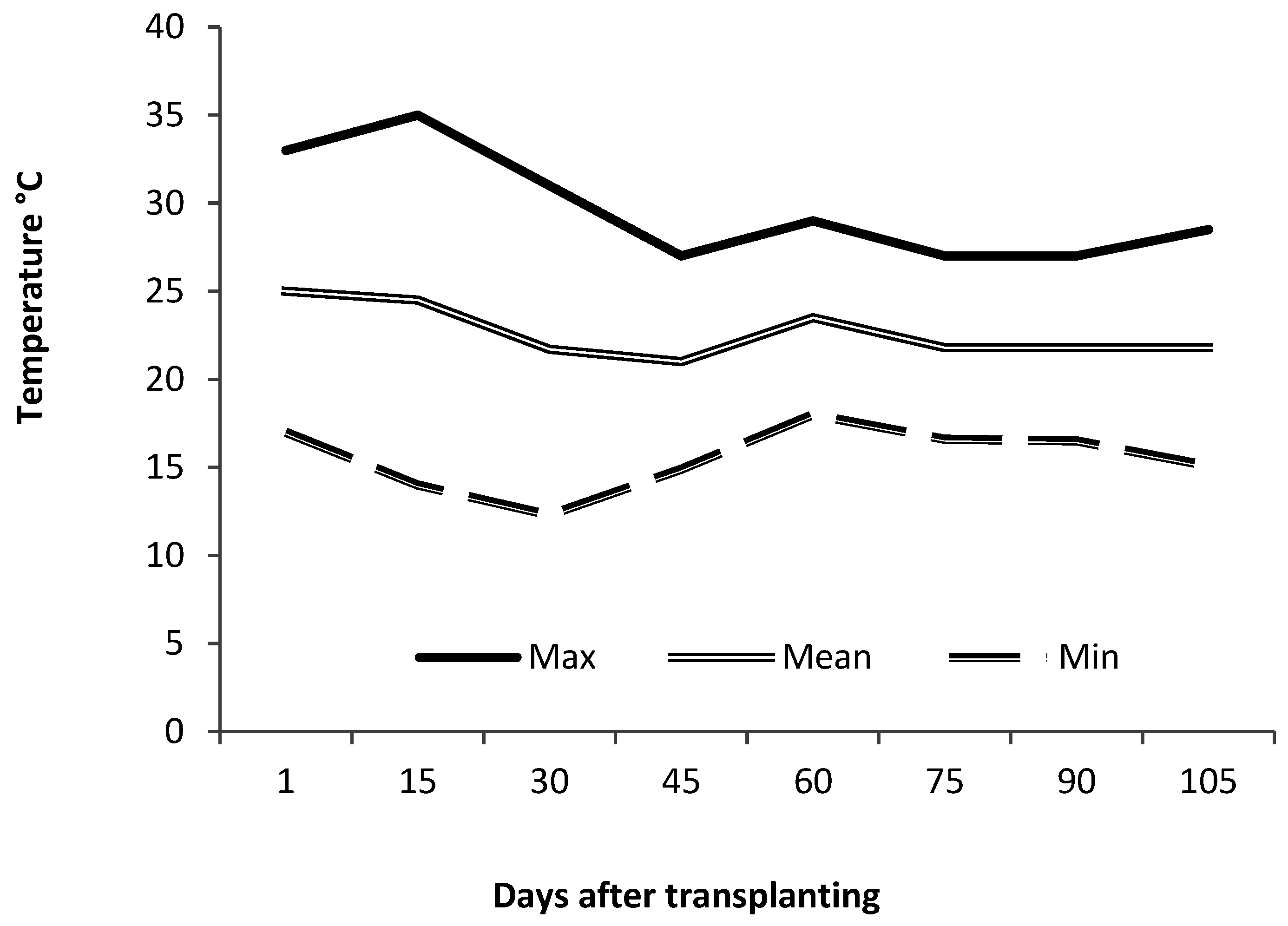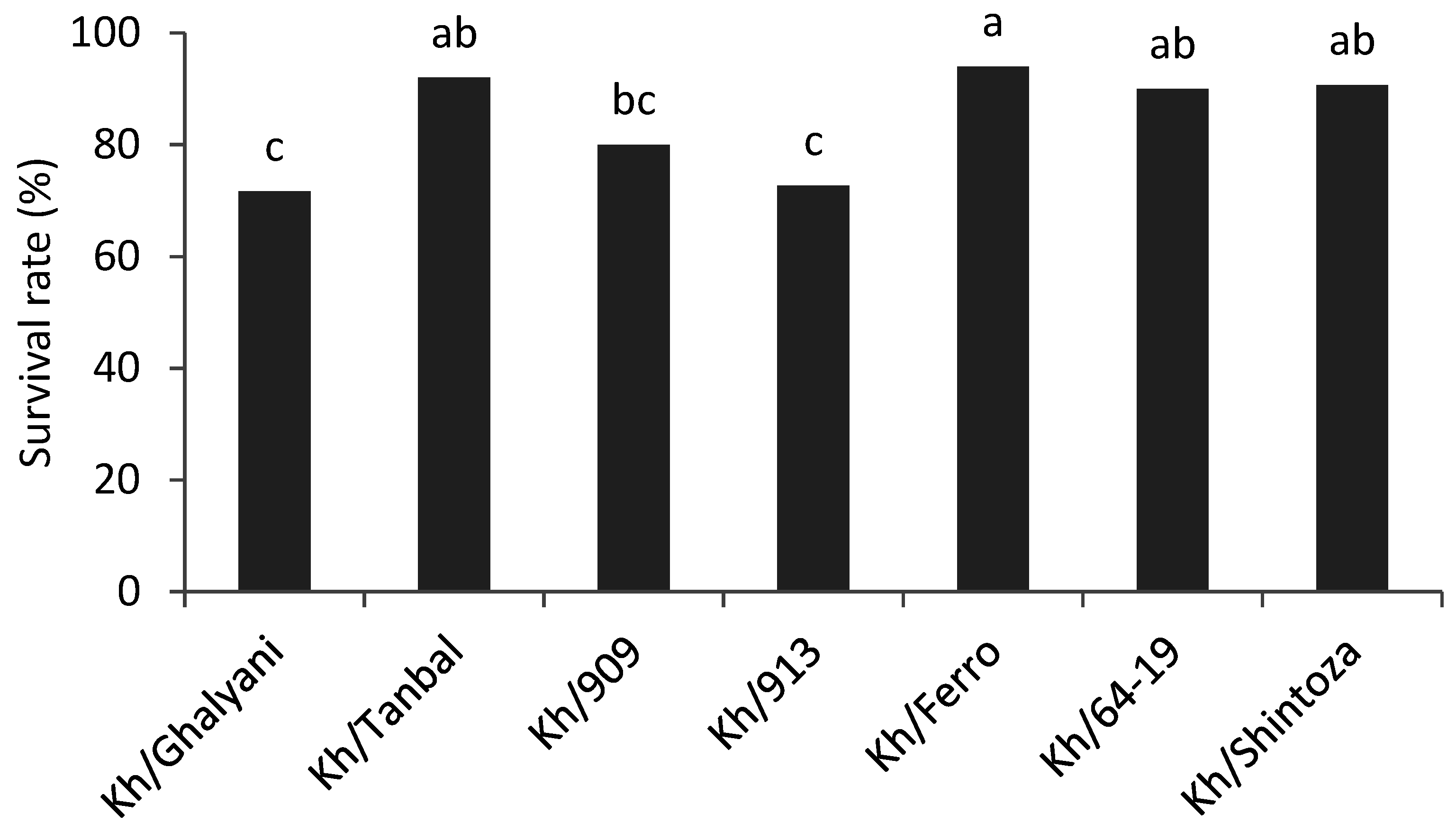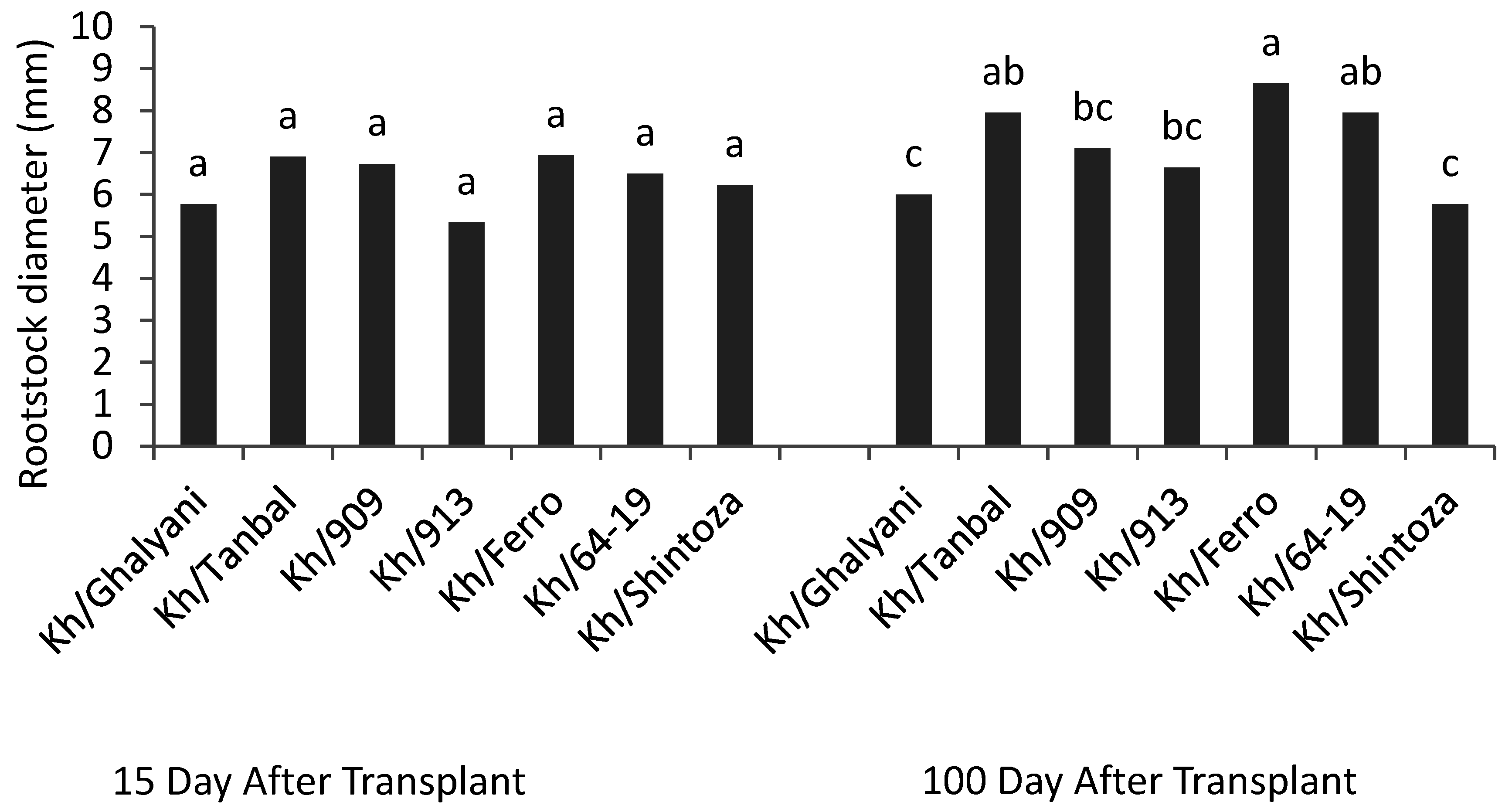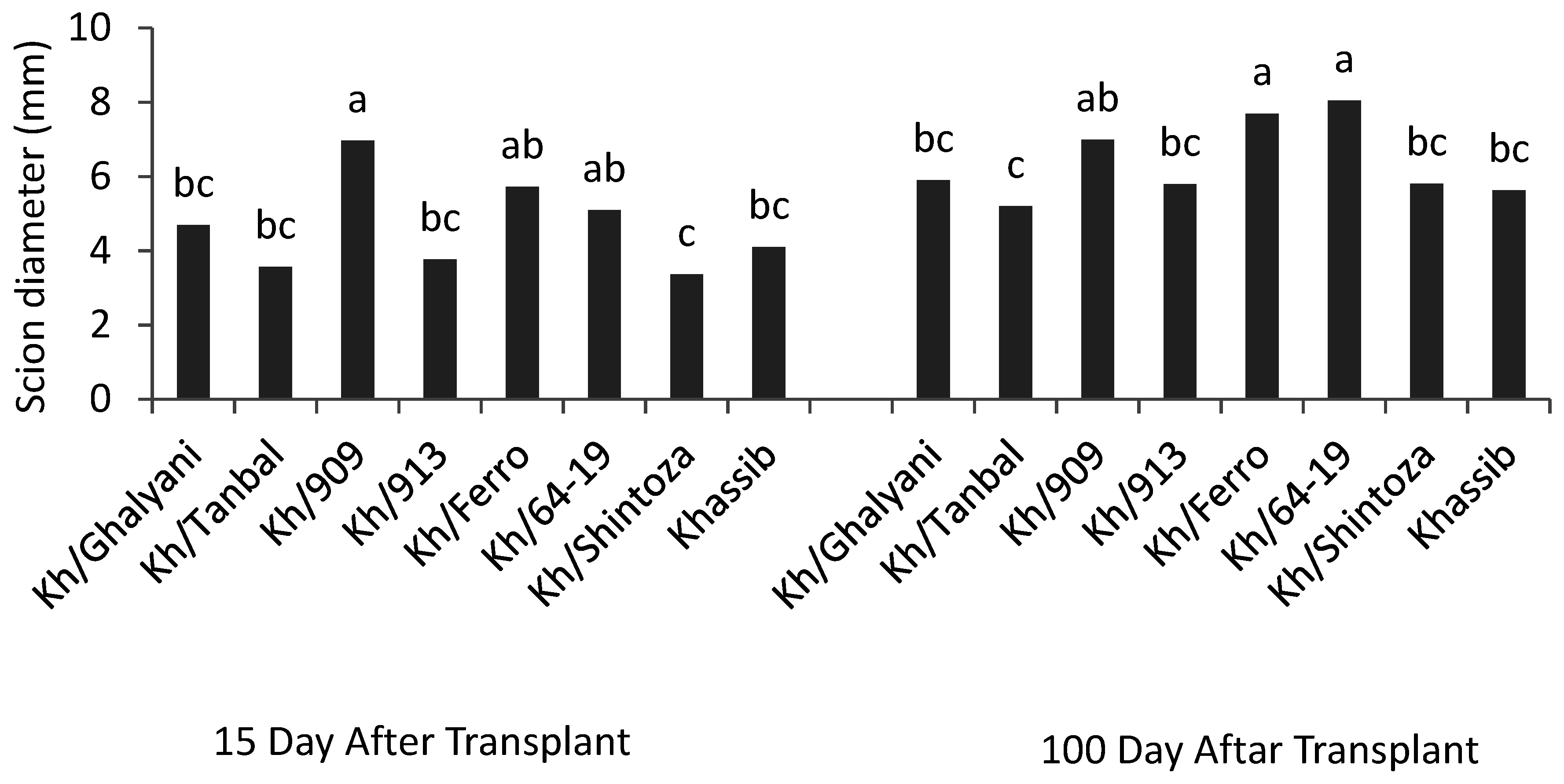The Effectiveness of Different Rootstocks for Improving Yield and Growth of Cucumber Cultivated Hydroponically in a Greenhouse
Abstract
:1. Introduction
2. Experimental Section
2.1. Plant Material, Treatments and Growth Conditions

2.2. Survival Rate and Plant Growth
2.3. Yield and Fruit Quality Parameters
2.4. Statistical Analysis
3. Results
3.1. Plant Growth



| Treatments | Root Dry Weight (g/plant) | Root Length (cm) | Shoot Dry Weight (g/plant) | R/S | Plant Height (cm) | Node Number | Leaf Area (cm2/plant) |
|---|---|---|---|---|---|---|---|
| Kh/Ghalyani | 0.52 c | 37.5 c | 6.4 e | 0.11 c | 60.7 f | 18 d | 480.8 b |
| Kh/Tanbal | 1.58 b | 52.0 ab | 12.7 c | 0.12 c | 98.0 e | 23 cd | 904.4 a |
| Kh/909 | 2.16 a | 48.0 abc | 15.3 b | 0.14 bc | 146.5 cd | 31 bc | 634.1 ab |
| Kh/913 | 1.23 b | 57.0 a | 8.5 d | 0.15 bc | 95.0 e | 16 d | 558.5 ab |
| Kh/Ferro | 2.73 a | 59.0 a | 18.7 a | 0.15 bc | 161.5 bc | 32 b | 612.9 ab |
| Kh/64-19 | 2.34 a | 47.0 abc | 11.9 c | 0.20 ab | 130.5 d | 33 b | 555.5 ab |
| Kh/Shintoza | 2.35 a | 41.0 bc | 10.8 c | 0.22 a | 241.0 a | 43 a | 613.5 ab |
| Ungrafted | 2.49 a | 48.0 abc | 15.9 b | 0.16 bc | 179.5 b | 28 bc | 734.2 ab |
| Significance 1 | *** | * | *** | * | *** | *** | * |
3.2. Yield Parameters
| Treatments | Yield (g/m2) | Fruit Number (n/plant) | Marketable Fruit (%) | TSS (Brix) | Fruit Dry Weight (g) | Fruit Diameter (cm) | Fruit Shape (L/D) 2 |
|---|---|---|---|---|---|---|---|
| Kh/Ghalyani | 2954 de | 13.7de | 82.0 bc | 3.3 cd | 3.66 b | 2.6 bc | 4.2 a |
| Kh/Tanbal | 4096 bc | 16.0cd | 96.5 a | 3.5 bc | 4.98 a | 3.1 a | 3.2 c |
| Kh/909 | 4946 bc | 23.7 abc | 80.9 cd | 3.9 b | 4.23 ab | 2.5 c | 4.7 a |
| Kh/913 | 1384 e | 5.25 e | 68.7 d | 3.2 cd | 3.39 b | 2.9 ab | 3.7 ab |
| Kh/Ferro | 6657 a | 29.5 a | 94.7 ab | 3.2 cd | 3.39 b | 2.9 ab | 3.4 bc |
| Kh/64-19 | 3407 cd | 16.1 cd | 91.8 abc | 3.9 b | 3.69 b | 2.6 bc | 3.1 c |
| Kh/Shintoza | 4337 bc | 20.0 bcd | 80.0 cd | 2.9 d | 4.87 a | 2.7abc | 3.5 bc |
| Ungrafted | 5234 ab | 27.0 ab | 90.5 abc | 4.8 a | 5.15 a | 2.4 c | 3.7 ab |
| Significance 1 | *** | *** | ** | *** | ** | ** | ** |
3.3. Fruit Quality Analysis
4. Discussion
5. Conclusions
Author Contributions
Conflict of Interest
References
- FAO. Statistics at FAO. Available online: www.fao.org/statistics/en (accessed on 25 December 2015).
- Kubota, C.; McClure, M.A.; Kokalis-Burelle, N.; Bausher, M.G.; Rosskopf, E.N. Vegetable grafting: History, use, and current technology status in north America. HortScience 2008, 43, 1664–1669. [Google Scholar]
- Lee, J.M.; Kubota, C.; Tsao, S.J.; Bie, Z.; Echevarria, P.H.; Morra, L.; Oda, M. Current status of vegetable grafting: Diffusion, grafting techniques, automation. Sci. Hort. 2010, 127, 93–105. [Google Scholar] [CrossRef]
- Savvas, D.; Colla, G.; Rouphael, Y.; Schwarz, D. Amelioration of heavy metal and nutrient stress in fruit vegetables by grafting. Sci. Hort. 2010, 127, 156–161. [Google Scholar] [CrossRef]
- Schwarz, D.; Rouphael, Y.; Colla, G.; Venema, J.H. Grafting as a tool to improve tolerance of vegetables to abiotic stresses: Thermal stress, water stress and organic pollutants. Sci. Hort. 2010, 127, 162–171. [Google Scholar] [CrossRef]
- Edelstein, M.; Burger, Y.; Horev, C.; Porat, A.; Meir, A.; Cohen, R. Assessing the effect of genetic and anatomic variation of Cucurbita rootstocks on vigour, survival and yield of grafted melons. J. Hort. Sci. Biotechnol. 2004, 79, 370–374. [Google Scholar]
- Cohen, R.; Burger, Y.; Horev, C.; Koren, A.; Edelstein, M. Introducing grafted cucurbits to modern agriculture: The Israeli experience. Plant Dis. 2007, 91, 916–923. [Google Scholar] [CrossRef]
- Davis, A.R.; Perkins-Veazie, P.; Hassell, R.; Levi, A.; King, S.R.; Zhang, X. Grafting effects on vegetable quality. HortScience 2008, 43, 1670–1672. [Google Scholar]
- Rouphael, Y.; Schwarz, D.; Krumbein, A.; Colla, G. Impact of grafting on product quality of fruit vegetables. Sci. Hort. 2010, 127, 172–179. [Google Scholar] [CrossRef]
- Lee, J.M. Cultivation of grafted vegetables: 1. Current status, grafting methods, and benefits. HortScience 1994, 29, 235–239. [Google Scholar]
- Zhang, Z.; Liu, S.; Hao, S.; Liu, S. Grafting increases the copper tolerance of cucumber seedlings by improvement of polyamine contents and enhancement of antioxidant enzymes activity. Agr. Sci. China 2010, 9, 985–994. [Google Scholar] [CrossRef]
- Oda, M.; Tsuji, K.; Sasaki, H. Effect of hypocotyl morphology on survival rate and growth of cucumber seedling grafted on Cucurbita spp. Jap. Agr. Res. Quart. 1993, 26, 259–263. [Google Scholar]
- Traka-Mavrona, E.; Koutsika-Sotiriou, M.; Pritsa, T. Response of squash (Cucurbita spp.) as rootstock for melon (Cucumis melo L.). Sci. Hort. 2000, 83, 353–362. [Google Scholar] [CrossRef]
- Pérez-Alfocea, F.; Albacete, A.; Ghanem, M.E.; Dodd, I.C. Hormonal regulation of source-sink relations to maintain crop productivity under salinity: A case study of root-to-shoot signaling in tomato. Funct. Plant Biol. 2010, 7, 592–603. [Google Scholar] [CrossRef]
- Colla, G.; Rouphael, Y.; Cardarelli, M.; Salerno, A.; Rea, E. The effectiveness of grafting to improve alkalinity tolerance in watermelon. Environ. Experim. Bot. 2010, 68, 283–291. [Google Scholar] [CrossRef]
- Lopez-Galarza, S.; San Bautista, A.; Perez, D.M.; Miguel, A.; Baixauli, C.; Pascual, B.; Maroto, J.V.; Guardiola, J.L. Effects of grafting and cytokinin-induced fruit setting on colour and sugar-content traits in glasshouse-grown triploid watermelon. J. Hort. Sci. Biotechnol. 2004, 79, 971–976. [Google Scholar]
© 2016 by the authors; licensee MDPI, Basel, Switzerland. This article is an open access article distributed under the terms and conditions of the Creative Commons by Attribution (CC-BY) license (http://creativecommons.org/licenses/by/4.0/).
Share and Cite
Farhadi, A.; Aroeii, H.; Nemati, H.; Salehi, R.; Giuffrida, F. The Effectiveness of Different Rootstocks for Improving Yield and Growth of Cucumber Cultivated Hydroponically in a Greenhouse. Horticulturae 2016, 2, 1. https://doi.org/10.3390/horticulturae2010001
Farhadi A, Aroeii H, Nemati H, Salehi R, Giuffrida F. The Effectiveness of Different Rootstocks for Improving Yield and Growth of Cucumber Cultivated Hydroponically in a Greenhouse. Horticulturae. 2016; 2(1):1. https://doi.org/10.3390/horticulturae2010001
Chicago/Turabian StyleFarhadi, Ali, Hossain Aroeii, Hossain Nemati, Reza Salehi, and Francesco Giuffrida. 2016. "The Effectiveness of Different Rootstocks for Improving Yield and Growth of Cucumber Cultivated Hydroponically in a Greenhouse" Horticulturae 2, no. 1: 1. https://doi.org/10.3390/horticulturae2010001
APA StyleFarhadi, A., Aroeii, H., Nemati, H., Salehi, R., & Giuffrida, F. (2016). The Effectiveness of Different Rootstocks for Improving Yield and Growth of Cucumber Cultivated Hydroponically in a Greenhouse. Horticulturae, 2(1), 1. https://doi.org/10.3390/horticulturae2010001






